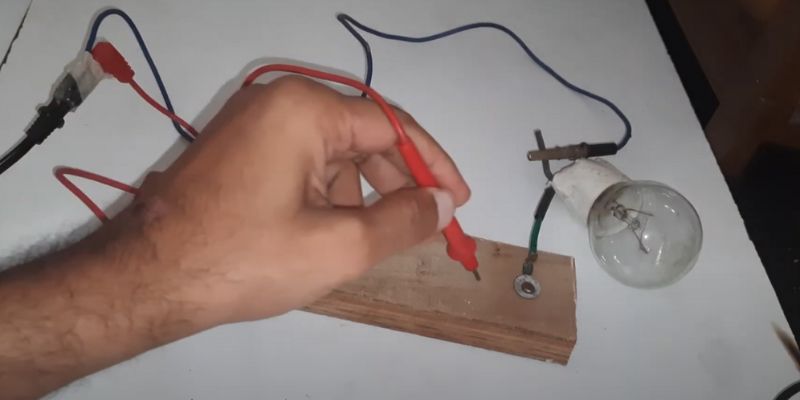Yes, wood is a poor conductor of electricity. Wood exhibits minimal electrical conductivity, making it a good insulator and reducing the risk of electrical shock or short-circuiting in wooden structures or products.
This natural property of wood is derived from its cellular structure, which is primarily composed of non-metallic substances such as cellulose and lignin. Due to its low electrical conductivity, wood’s resistance to the flow of electricity is significantly higher compared to conductive materials like metal.
This characteristic makes wood a preferred choice for various applications, including the construction of electrical insulators, furniture, and other wooden objects. Additionally, its insulating capabilities also contribute to the energy efficiency of wooden buildings, providing natural thermal insulation.
Understanding The Physics Of Conductivity
Conductivity is an essential concept in the realm of physics. It refers to the ability of materials to conduct electric current. Whether an object can conduct electricity depends on certain factors, which we will explore in this section. Additionally, there are different types of conductivity that play a crucial role in determining how a material interacts with electric currents.
What Is Conductivity?
Conductivity, in simple terms, is the measure of how easily electric charge can flow through a given material. It is determined by the presence of free electrons in the material. Free electrons are those that are not tightly bound to a specific atom or molecule, making them available to move and carry electric charge. When a voltage is applied across a material, it creates an electric field, which causes these free electrons to move in a coordinated manner, creating an electric current.
Factors Affecting Conductivity
Conductivity can be influenced by various factors, which are:
- Temperature: Temperature plays a significant role in conductivity. In general, as the temperature increases, the conductivity of most materials decreases. This happens because higher temperatures increase the level of atomic vibrations, which can impede the flow of free electrons.
- Material composition: The composition of a material greatly affects its conductivity. Some materials, like metals, have high conductivity due to their abundance of free electrons. Others, like insulators, have low conductivity because their electrons are tightly bound to atoms, minimizing their ability to move freely.
- Purity of the material: Impurities in a material can negatively affect its conductivity. These impurities can introduce defects in the crystal structure, disrupting the flow of electrons and reducing conductivity.
- Crystal structure: The arrangement of atoms within a material’s crystal lattice influences its conductivity. Some crystal structures, such as those found in metals, allow for greater electron mobility, leading to higher conductivity.

Different Types Of Conductivity
There are various types of conductivity that demonstrate how materials interact with electric currents. These include:
- Electrical conductivity: This type of conductivity refers to the flow of electric charge through a given material when a voltage is applied. Materials with high electrical conductivity, like metals, allow electric charge to pass through easily.
- Thermal conductivity: Thermal conductivity relates to how well a material can conduct heat. It is the rate at which heat flows through a specific material. Materials with high thermal conductivity, such as metals and some ceramics, efficiently transfer heat.
- Electronic conductivity: Electronic conductivity is specific to materials that allow the movement of electrons, usually through their conduction band. Semiconductors and conductors exhibit this type of conductivity.
- Ionic conductivity: Ionic conductivity involves the movement of ions within a material. It is commonly found in electrolytes, such as those used in batteries and fuel cells.
- Superconductivity: Superconductivity refers to the ability of certain materials to conduct electric current with zero electrical resistance at extremely low temperatures. This phenomenon has various applications in medical imaging, energy transmission, and particle accelerators.
Debunking The Myth: Wood As A Conductor
Wood is a material that has been used for centuries in various applications, from building houses to crafting furniture. However, there is a common misconception that wood is conductive. In this article, we will explore the science behind wood’s electrical properties and debunk the myth that wood is a conductor. So, let’s dive in and explore why wood is not conductive.
Explanation Of Why Wood Is Not Conductive
Wood is primarily composed of cellulose, hemicellulose, and lignin, which are organic compounds. Unlike metals, which are excellent conductors of electricity due to the presence of free electrons, wood does not possess the same conductivity properties.
The reason behind this lies in the atomic structure of wood. Atoms in wood are held together by strong covalent bonds, where electrons are shared between atoms in a stable configuration. This electron sharing limits the movement of electrons, making wood a poor conductor of electricity.
Discussion Of Wood’s Electrical Resistance Properties
While wood may not conduct electricity like metals do, it does possess electrical resistance. Electrical resistance refers to the opposition of a material to the flow of electric current.
Wood has a relatively high electrical resistance compared to metals, meaning that it restricts the flow of electricity to a greater extent. This property makes wood suitable for applications where insulating electrical components is desired, such as in the construction of electrical cabinets and insulating materials.
Additionally, wood’s electrical resistance properties can also be advantageous in providing protection against electrical shocks. When properly utilized, wood can act as an insulator and minimize the risk of electrically related accidents in certain situations.
Scientific Evidence Supporting The Non-conductivity Of Wood
There have been various scientific studies and experiments conducted to prove that wood is not conductive. These studies have consistently shown that wood has low electrical conductivity and high resistance to the flow of electricity.
For example, a study published in the Journal of Physical Chemistry C investigated the electrical properties of different types of wood. The researchers found that the conductivity of wood was several orders of magnitude lower than that of metals, further reinforcing the fact that wood is not conductive.
Moreover, researchers have also measured the resistivity of wood using techniques such as four-point probe measurements. These measurements have consistently shown that wood has high resistivity, corroborating the scientific consensus that wood does not conduct electricity efficiently.
In conclusion, despite the misconception that wood is conductive, scientific evidence clearly demonstrates otherwise. Wood’s organic composition and atomic structure make it a poor conductor of electricity. However, its electrical resistance properties make it useful for various applications where insulation is required. So, the next time someone claims that wood conducts electricity, you can confidently debunk the myth with the knowledge that wood is indeed non-conductive.
Exploring The Role Of Moisture Content
One fascinating aspect of wood is its ability to conduct electricity under certain conditions. The conductivity of wood is influenced by various factors, and among them, moisture content plays a significant role. In this section, we will delve into the effect of moisture on wood conductivity, explaining how wood can become conductive in certain conditions. We will also provide examples of how moisture affects conductivity in wood, shedding light on this intriguing phenomenon.
Effect Of Moisture On Wood Conductivity
Moisture content is a crucial factor that affects the conductivity of wood. Wood is a hygroscopic material, meaning it can absorb and release moisture from its surroundings. As moisture penetrates the wood fibers, it can significantly impact its conductivity properties. Specifically, the presence of moisture increases the conductive ability of wood, allowing it to transmit electricity more effectively.
When wood absorbs moisture, it effectively becomes a conductor due to the presence of ions in the water. These ions create pathways for electricity to flow through the wood, resulting in increased conductivity. Therefore, the moisture content within wood can directly influence its ability to conduct electrical currents.
Explanation Of Wood’s Ability To Become Conductive In Certain Conditions
Wood’s ability to become conductive in certain conditions can be attributed to its unique structure. The cell walls of wood consist of cellulose, hemicellulose, and lignin, which create a complex matrix. When wood absorbs moisture, the water molecules fill the spaces between these cell wall components. As a result, the water molecules provide an easier path for the flow of electrical charges, facilitating the conduction of electricity.
In addition to the structural aspect, the dissolved ions present in the absorbed moisture contribute to the increased conductivity of wood. These ions, such as sodium, potassium, and calcium, act as charge carriers, supporting the flow of electrical currents through the wood matrix. Thus, the combination of the water molecules and the presence of ions within the wood structure enable wood to become conductive under specific moisture conditions.
Examples Of How Moisture Affects Conductivity In Wood
To better understand how moisture influences the conductivity of wood, let’s explore some examples:
- Dry Wood: When wood is extremely dry, with minimal moisture content, its conductivity is significantly reduced. The lack of moisture limits the presence of ions and water molecules, hindering the flow of electrical charges through the wood’s cell structure.
- Increased Moisture: On the other hand, as the moisture content of wood increases, its conductivity improves. The absorbed water molecules create pathways for the flow of electrical charges, promoting increased conductivity.
- Wet Wood: When wood becomes saturated with moisture, it can exhibit even higher conductivity. The abundance of water molecules and ions within the wood structure allows for more efficient flow of electrical currents, resulting in enhanced conductivity.
In conclusion, by examining the role of moisture content in wood conductivity, we can understand how the presence of water molecules and ions influences the ability of wood to conduct electricity. The unique structure of wood, combined with the absorption of moisture, creates pathways for electrical charges, enabling wood to become conductive under specific conditions.

Practical Implications And Applications
Understanding the implications of wood’s conductive properties is critical in various practical applications, especially in electrical installations and safety. Additionally, wood’s natural insulating properties make it an ideal material in construction projects. In this section, we will delve into the practical implications and applications of wood’s conductivity, exploring its role in electrical installations and safety, as well as its application as an insulator in construction.
Understanding The Implications For Electrical Installations And Safety
Wood’s conductive properties have significant implications for electrical installations and safety. While wood is generally a poor conductor of electricity, caution must be exercised when incorporating wood into electrical systems. By understanding the conductivity of different wood species, electricians and engineers can make informed decisions to ensure the safety and efficiency of electrical installations.
It is crucial to note that wood itself does not conduct electricity to a dangerous extent. However, when moisture or other conductive substances come into contact with wood, the risk of electrical conduction increases. Consequently, proper grounding and insulation techniques are imperative when working with wood in electrical installations to minimize the risk of electrical shock or fires.
Wood As An Insulator In Construction
Wood, with its inherent non-conductive properties, serves as an exceptional insulating material in construction. In contrast to conductive materials like metal, wood effectively resists the flow of electric current due to its high electrical resistance. This quality makes wood a popular choice for electrical wiring encasements and insulating electrical panels, safeguarding the integrity and functionality of electrical systems.
Furthermore, in construction applications, wood acts as a thermal insulator, helping to regulate temperature and increase energy efficiency. The natural insulation properties of wood help to maintain comfortable indoor environments by reducing heat transfer, thereby decreasing the need for excessive heating or cooling. This not only contributes to environmental sustainability but also leads to potential cost savings for homeowners and businesses.
Applications Of Wood’s Non-conductive Properties
The non-conductive properties of wood find numerous applications beyond electrical installations and construction. Let’s explore some of the practical uses where wood’s non-conductivity plays a crucial role:
- Manufacturing of wooden handles for tools and utensils, providing insulation against heat and electricity.
- Production of wooden furniture, ensuring safety and reducing the risk of electric shock.
- Creation of wooden flooring, offering a warm, comfortable surface while reducing the risk of static discharge.
- Use of wood in musical instruments, particularly those with electrical components, to prevent interference or signal degradation.
- Integration of wood in electronic enclosures to provide electrical insulation and protect sensitive components from external forces.
It is essential to recognize that wood’s non-conductive properties extend its applications well beyond the traditional realm of construction. By harnessing the non-conductivity of wood in diverse industries, we can maximize safety, enhance performance, and unleash the unique potential of this versatile material.
Frequently Asked Questions On Is Wood Conductive
Is Wood A Conductor Of Electricity?
Yes, wood is a poor conductor of electricity due to its composition and high resistance. Its electrons are tightly bound, making it difficult for electricity to flow through it.
Can You Conduct Electricity Through Wood?
Yes, wood can conduct electricity to some extent due to its moisture content. However, compared to metals and other conductive materials, wood is considered a poor conductor of electricity.
Why Can’t Electricity Flow Through Wood?
Electricity cannot flow through wood because wood is an insulator, not a conductor of electricity. Its atomic structure prevents the movement of electric charges, making it unable to conduct an electric current.
Does Wood Conduct Electricity Lightning?
Yes, wood conducts electricity to a certain extent due to the presence of water and other impurities. However, it is a poor conductor compared to metals and is not likely to conduct lightning effectively.
Conclusion
Wood’s conductivity properties have been a subject of curiosity. Through our exploration, we have learned that wood is not inherently conductive, but its moisture content and specific types can alter its conductivity. Understanding this distinction is crucial in various applications, such as electrical circuits or insulation.
So, next time you ponder upon wood’s conductivity, remember its unique characteristics, which make it a versatile material with limitless possibilities.



2 thoughts on “Is Wood Conductive? Debunking the Myth and Unveiling the Truth”